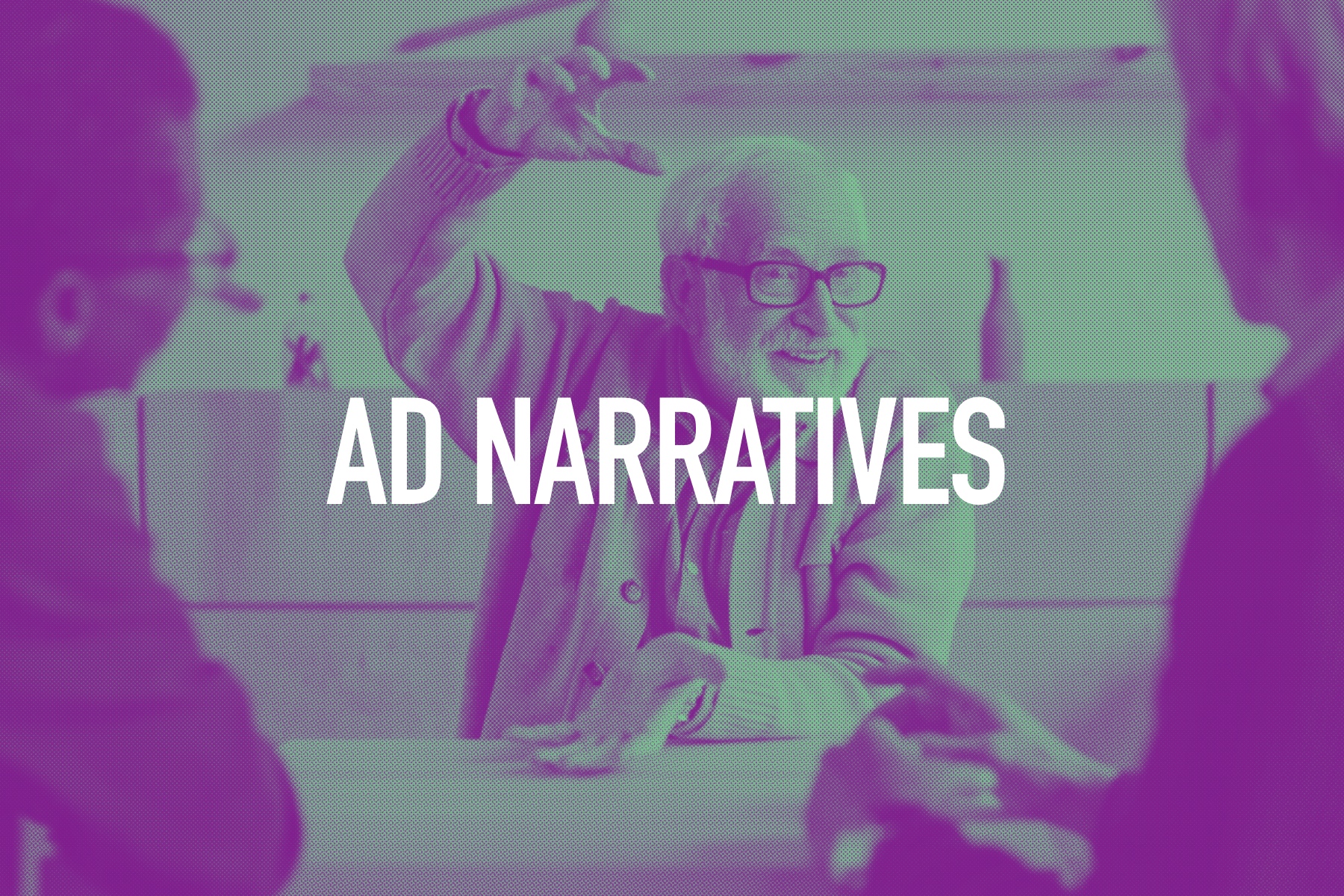Table of Contents
In the ever-evolving landscape of digital marketing, the effectiveness of advertising efforts has become a paramount concern for businesses aiming to capture and retain consumer interest. Amidst the constant stream of online content, digital ads face the significant challenge of breaking through the noise to grab attention and drive consumer action. The efficacy of these digital advertisements, therefore, hinges not just on their visibility but on their ability to resonate deeply with audiences. This is where the power of narrative comes into play.
Narrative advertising goes beyond the mere presentation of a product or service; it weaves a story that connects with the audience personally. Humans are innately drawn to stories—they are how we make sense of the world around us. A well-crafted narrative can transport individuals, evoke emotions, and, most importantly, drive engagement and conversion by creating a memorable experience.
The significance of narratives in digital advertising cannot be overstated. They embody the essence of creative marketing, transforming mundane messages into captivating stories. This transition from straightforward advertising to narrative-driven content represents a shift towards a more holistic and engaging approach to digital marketing.
However, the journey from recognizing the potential of narratives in digital ads to successfully implementing them is complex and nuanced. It requires a deep understanding of storytelling principles, audience psychology, and the digital medium itself. In the forthcoming sections, we will delve into the psychological underpinnings of storytelling in marketing, explore elements of compelling digital narratives, and examine scientific studies that highlight the effectiveness of narrative advertising. Our exploration will provide a comprehensive framework for crafting digital ads that not only capture attention but also convert, cementing the role of narratives as a powerful tool in the digital advertiser’s arsenal.
The essence of narrative advertising lies in its ability to forge a connection between brand and consumer, transcending the traditional advertiser-audience dynamic. It’s about creating a shared experience, one that invites the audience into the story and makes them an integral part of the narrative journey. As we proceed, we’ll uncover the strategies behind successful narrative ads, the challenges faced in creating them, and the future trends that will shape the landscape of digital advertising efficacy. Through this deep dive, we aim to equip marketers with the knowledge and tools to harness the transformative power of narratives, crafting ads that not only resonate but also convert, marking a new era in digital advertising.
The Power of Storytelling in Digital Ads
Storytelling, an art as ancient as humanity itself, holds a unique power to engage, influence, and inspire action. This timeless mechanism for sharing experiences and conveying values is particularly potent in digital marketing, where the competition for consumer attention is fierce. The power of storytelling in digital ads lies in its ability to transform a simple message into a compelling narrative that forges an emotional connection with the audience.
Psychological Underpinnings of Storytelling in Marketing
The effectiveness of storytelling is deeply rooted in psychology. Stories engage the brain more fully than factual lists of features or benefits ever could. When individuals listen to stories, not only are the language processing parts of their brains activated, but so are the areas they would use when experiencing the events of the story themselves. This immersive experience fosters a stronger emotional bond between the consumer and the narrative, enhancing memorability and influencing decision-making processes.
Neuroscientific research supports this, showing that stories can trigger the release of oxytocin, a hormone associated with empathy and relationship-building. This chemical reaction can increase trust in a brand and influence purchasing decisions. Moreover, a well-told story can act as a ‘Trojan horse,’ carrying a message directly into the heart of the audience, bypassing scepticism and resistance to traditional advertising.
Case Study Analysis of Successful Ad Campaigns with Strong Narratives
One illuminating example is Airbnb’s “We Accept” campaign, which artfully narrated the brand’s commitment to inclusivity and acceptance, regardless of race, nationality, or orientation. The campaign’s narrative resonated deeply with viewers, driving positive brand perception and user engagement.
Similarly, Google’s “Parisian Love” ad tells a captivating story using only search queries, showcasing how their service can play a role in life’s key moments. The simplicity of the narrative, coupled with the emotional journey, made this ad particularly effective and memorable.
Elements of a Compelling Digital Narrative
Creating a compelling narrative requires more than just a story. It demands elements that resonate on a personal level with the audience, inviting them into the narrative and making them care about the outcome.
The Role of Characters, Setting, Conflict, and Resolution in Ad Narratives
- Characters: The audience must see themselves in the characters or aspire to be like them. Characters should be well-developed and relatable, embodying the desires, challenges, or values of the target audience.
- Setting: The backdrop against which the story unfolds should be vivid and immersive, providing context and enhancing the emotional or experiential journey of the narrative.
- Conflict: Essential to any story, the conflict introduces tension or challenges that the characters must overcome. It’s the driving force of the narrative, creating engagement and anticipation.
- Resolution: The conclusion of the story should offer a satisfying resolution to the conflict, ideally linking back to the product or service as a key component of the solution. This reinforces the brand’s value proposition in a subtle yet powerful way.
How These Elements Influence Consumer Engagement and Conversion
Together, these narrative elements craft a journey that captivates the audience, making the ad memorable and impactful. A compelling narrative can significantly enhance brand recall, emotional engagement, and the likelihood of sharing the ad with others, amplifying its reach and effectiveness.
Moreover, narratives that skillfully integrate these elements can elevate the perceived value of a product or service, making it not just a purchase but a key player in the consumer’s own life story. This deepens the brand-consumer relationship, fostering loyalty and encouraging conversion.
Strategies for Crafting Effective Ad Narratives
Crafting an effective ad narrative requires more than just a creative spark; it necessitates a strategic approach that intertwines storytelling with marketing objectives. The creation of narratives that resonate with target audiences involves understanding their preferences, pain points, and aspirations. Below, we delve into practical guidelines for developing narratives that not only captivate but also convert.
Practical Guidelines for Developing Narratives
- Understand Your Audience: Begin with a deep understanding of your target audience. Use demographic and psychographic data to craft personas that represent your audience segments. Knowing their motivations, challenges, and what they value in a story will guide the narrative’s direction.
- Incorporate Relatable Characters: Characters are the heart of any narrative. Develop characters that mirror your audience’s demographics or aspirations, making it easier for them to see themselves in the story. This creates a personal connection and increases engagement.
- Build a Cohesive Plot: A strong narrative has a clear beginning, middle, and end. Introduce a conflict or problem your audience can relate to, show how your product or service offers a resolution, and conclude with a satisfying outcome. This structure should be evident, no matter how brief the ad.
- Emphasize Emotional Appeal: Emotions drive decisions. Whether it’s happiness, nostalgia, or even fear, tapping into emotions can make your narrative more compelling. Ensure that the story evokes an emotional response that aligns with your brand message.
- Integrate the Product Seamlessly: While the narrative should be engaging, the ultimate goal is to highlight your product or service. Ensure that its inclusion feels natural and essential to the story, rather than forced or superficial.
- Leverage Multiple Platforms: Consider how your narrative can be adapted across different platforms, each with its unique storytelling tools, such as Instagram Stories or YouTube videos. Consistency in narrative across platforms enhances brand recall.
The Balance between Storytelling and Direct Product Promotion
Maintaining a balance between storytelling and product promotion is crucial. Overemphasis on the product can disrupt the narrative flow, making the ad feel more like a traditional sales pitch. Conversely, a story that scarcely mentions the product risks losing the promotional message. The key is to weave the product into the story in a way that feels essential to the narrative’s resolution, ensuring the story drives interest towards the product or service naturally.
Measuring the Impact of Narrative Ads on Conversion Rates
Understanding the effectiveness of narrative advertising is essential for refining strategies and justifying investment in creative ad campaigns. This section explores metrics, analytics, and testing methods for assessing the performance of narrative-driven ads.
Overview of Metrics and Analytics for Assessing Ad Performance
- Engagement Metrics: Track likes, shares, comments, and viewing duration to gauge how audiences are interacting with your narrative ad. High engagement often indicates a strong connection with the narrative.
- Conversion Rates: Measure how many viewers take the desired action (e.g., making a purchase, signing up for a newsletter) after engaging with the ad. This directly reflects the ad’s effectiveness in driving conversions.
- Brand Recall and Recognition: Surveys and brand lift studies can assess how well audiences remember your ad and brand after exposure, indicating the narrative’s memorability and impact.
- Sentiment Analysis: Analysing the tone and content of audience feedback can provide insights into how the narrative is perceived and its emotional impact.
Discussion of A/B Testing Methods for Narrative vs. Non-Narrative Ads
A/B testing, or split testing, is a valuable method for comparing the effectiveness of narrative ads against non-narrative ads. By presenting two versions of an ad to similar audiences and measuring which performs better in terms of engagement and conversion rates, marketers can obtain concrete data on the narrative’s impact.
- Creating the Test: Develop two versions of your ad—one narrative-driven and one focusing more traditionally on the product or service without storytelling.
- Choosing the Right Metrics: Depending on your marketing goals, select appropriate metrics for comparison, such as click-through rates, conversion rates, or engagement levels.
- Analysing Results: Examine the data to identify which version achieved better performance. Insights gained can inform future marketing strategies and the role of narratives in your advertising efforts.
Narrative advertising offers a dynamic and impactful way to connect with audiences, but its success relies on strategic development, emotional resonance, and careful integration of product messages.
The Role of Visuals in Enhancing Narrative Ads
The integration of visuals into narrative advertising plays a crucial role in amplifying the story’s impact and engagement. In a digital age where users are bombarded with content, visually compelling narratives can capture attention, evoke emotions, and make the story more memorable. This section explores how visuals, when used effectively, can enhance the storytelling experience in digital ads.
Examining the Integration of Visuals and Storytelling
Visual elements, including images, videos, and animations, serve as powerful storytelling tools that can:
- Evoke Emotional Responses: Visuals can trigger emotions more directly and intensely than text alone. The right imagery or video can make the narrative’s emotional undertones palpable, fostering a deeper connection with the audience.
- Convey Complex Ideas Quickly: A single image or a short video can convey complex ideas or emotions much faster than words, making the narrative more accessible and engaging.
- Enhance Narrative Immersion: Visual storytelling can immerse the viewer in the narrative’s setting, making the story’s world more vivid and the experience more engaging.
- Facilitate Higher Retention: Visual information can be processed and remembered more easily than text. By incorporating visuals that align with the narrative, advertisers can enhance brand and message retention.
The Impact of Imagery, Video, and Interactive Elements on Narrative Engagement
- Imagery: Carefully chosen images that reflect key moments or emotions in the narrative can create visual anchors for the story, making it more relatable and impactful.
- Video: Videos offer a dynamic way to unfold a story, allowing for the depiction of characters, settings, and conflicts in a more engaging and comprehensive manner. The use of music, voiceovers, and pacing can further enhance the narrative’s emotional depth.
- Interactive Elements: Incorporating interactive elements like clickable hotspots, quizzes, or branching scenarios can turn passive viewers into active participants, deepening their engagement with the narrative and brand.
In leveraging these visual elements, it’s crucial to maintain a balance that ensures the visuals enhance rather than overshadow the narrative. The aim is to use visuals as a complement that enriches the story, making it more engaging and memorable without detracting from the narrative’s core message.
Future Trends in Digital Ad Narratives
As digital advertising continues to evolve, so too does the role of narratives within it. Looking ahead, several key trends are set to shape the future of narrative advertising, leveraging new technologies and shifting consumer expectations to create even more immersive and effective ad experiences.
Predictions for the Evolution of Storytelling in Advertising
- Increased Personalisation: Advances in data analytics and AI will enable more personalised narratives, tailoring stories to individual preferences, behaviours, and historical interactions with the brand.
- Interactive and Immersive Experiences: With the rise of augmented reality (AR) and virtual reality (VR), narrative ads can become more interactive and immersive, offering personalised, engaging experiences that blur the line between story and reality.
- Greater Emphasis on Authenticity: In an era of information overload, consumers crave authenticity. Narratives that reflect genuine stories, values, and experiences are likely to resonate more deeply and foster stronger brand loyalty.
- Leveraging User-Generated Content: Incorporating stories and experiences shared by real users can enhance the authenticity and relatability of narrative ads, fostering a sense of community and trust around the brand.
- Integration with Emerging Platforms: As new platforms and technologies emerge, so too will opportunities for innovative storytelling. Brands that adapt their narratives to these new mediums will stay ahead, engaging audiences in fresh and exciting ways.
The future of narrative advertising is one of boundless potential, characterized by deeper personalisation, immersive experiences, and authentic storytelling.
Conclusion
As we journey through the exploration of narratives in digital advertising, it becomes evident that storytelling is not just a marketing technique but a fundamental human experience leveraged to forge deeper connections between brands and their audiences. The efficacy of narrative advertising lies in its ability to transform product-centric messages into compelling stories that resonate on an emotional level, driving engagement and conversion in ways that traditional advertising cannot.
The power of storytelling in digital ads is rooted in its psychological appeal—stories engage the brain, evoke emotions, and foster a sense of empathy and trust. By incorporating relatable characters, immersive settings, meaningful conflicts, and satisfying resolutions, digital narratives invite the audience into a shared experience, making them more likely to engage with the brand and take the desired action.
However, crafting effective ad narratives requires a strategic blend of creativity and marketing acumen. It necessitates an understanding of the audience, a careful balance between storytelling and product promotion, and the integration of visuals to enhance the narrative’s impact. Moreover, the continuous measurement and analysis of the ad’s performance are crucial for refining strategies and ensuring that the narratives truly convert.
Looking ahead, the future of narrative advertising is bright and full of potential. Advances in technology and shifts in consumer expectations towards more personalised, immersive, and authentic experiences will shape the evolution of storytelling in digital ads. Brands that embrace these trends, leveraging the power of narratives while adapting to the changing digital landscape, will not only captivate their audiences but also drive meaningful engagement and conversion.
In essence, narratives that convert are those that transcend mere advertising, transforming into stories that audiences want to hear, share, and be a part of. As digital marketers, our challenge and opportunity lie in crafting these stories, blending the art of storytelling with the science of marketing to create narratives that not only resonate but also inspire action. Through a deep understanding of our audience and a commitment to authentic, engaging storytelling, we can elevate our digital advertising efforts, turning viewers into loyal customers and brand advocates in the process.
FAQs
How do narratives increase ad conversions?
Narratives boost ad conversions by engaging the audience on an emotional level, making the ad memorable and fostering a deeper connection with the brand. This emotional engagement encourages viewers to take the desired action, be it a purchase, subscription, or other forms of conversion.
Can every brand benefit from narrative advertising?
Yes, every brand can benefit from narrative advertising. Regardless of size or industry, weaving stories into digital ads can help brands connect with their audience more effectively. The key is to tailor the narrative to reflect the brand’s values and resonate with its target audience.
What are the essential components of a successful digital ad narrative?
A successful digital ad narrative should include relatable characters, a setting that draws the viewer in, a conflict or challenge that creates tension, and a resolution that ties back to the brand’s product or service as a solution, all while evoking an emotional response.
How important are visuals in narrative advertising?
Visuals are crucial in narrative advertising as they can significantly enhance the story’s impact, evoke emotions, and ensure the message is communicated more effectively and memorably. The right visuals complement the narrative, making it more engaging and immersive.
How can brands measure the effectiveness of their narrative ads?
Brands can measure the effectiveness of their narrative ads through various metrics such as engagement rates (likes, shares, comments), conversion rates, brand recall, and through the use of A/B testing to directly compare the performance of narrative ads against non-narrative ads.





